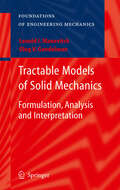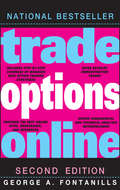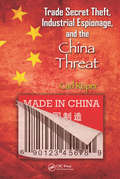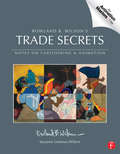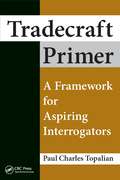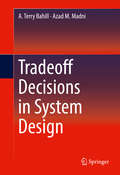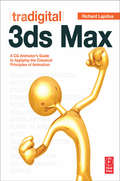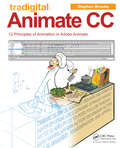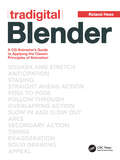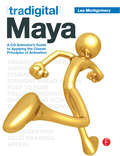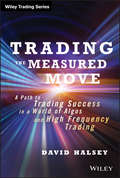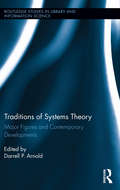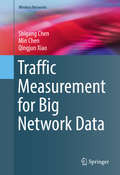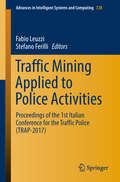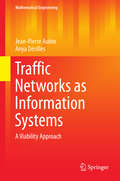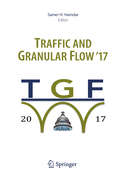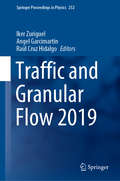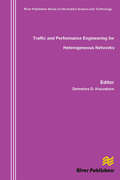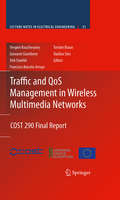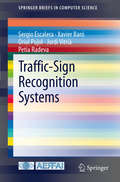- Table View
- List View
Tractable Models of Solid Mechanics
by Oleg V. Gendelman Leonid I. ManevitchThis book describes significant tractable models used in solid mechanics - classical models used in modern mechanics as well as new ones. The models are selected to illustrate the main ideas which allow scientists to describe complicated effects in a simple manner and to clarify basic notations of solid mechanics. A model is considered to be tractable if it is based on clear physical assumptions which allow the selection of significant effects and relatively simple mathematical formulations. The first part of the book briefly reviews classical tractable models for a simple description of complex effects developed from the 18th to the 20th century and widely used in modern mechanics. The second part describes systematically the new tractable models used today for the treatment of increasingly complex mechanical objects - from systems with two degrees of freedom to three-dimensional continuous objects.
Trade Mindfully: Achieve Your Optimum Trading Performance with Mindfulness and Cutting Edge Psychology
by Gary DaytonOvercome psychological obstacles to increase trading success<P><P> Successful traders need to be well-versed and skilled in a wide range of business and economic areas. But now, in addition to effective trading strategies and sound money management techniques, traders need to possess the know-how to handle the mental and emotional challenges of working in a highly volatile environment. Trade Mindfully is a unique resource that applies cutting-edge psychological techniques to trading skills, allowing readers to improve their mental outlooks and maximize the potential of their trading strategies. This book draws upon recent psychological research in behaviorism to teach new approaches that call for better focus, more confidence, and more positive perspectives and outcomes.<P> One of the key concepts covered in the book is mindfulness, a state of mind traditionally touted in the East for its ability to reduce stress and increase perspective, useful qualities for traders looking to rise above emotional obstacles and the poor results they cause. The author also discusses the importance of High Value Trading Actions (HVAs), specific actions that are under a trader's control. With this guide, trading professionals will be able to form solid strategies based on a combination of these notions and practices, leading to higher levels of trading performance.<P> * Applies sound psychological practice and evidence-based research to the trading profession<P> * Covers the psychological perspectives and mental skills needed to succeed in today's trading world<P> * Focuses on key concepts that lead to deliberate practice, specific trading activities, and increased awareness and focus<P> * Designed to help traders deal with the emotional challenges that come with uncertainty and risk<P> Trade Mindfully touches on the most essential concepts for anyone intrigued by what trading psychology has to offer, and delivers the best strategies for achieving the right mental skills for peak performance.
Trade Options Online
by George A. FontanillsIn this fully updated book, options trading innovator George Fontanills arms you with the knowledge and skills youneed to unleash the phenomenal power of your computer to become a successful online options trader. Following a concise review of the basics of online trading--including hardware and software requirements and essential online resources--Fontanills cuts to the chase with step-by-step coverage of proven managed risk option trading strategies. Specifically designed for online traders, these tested off-floor techniques provide you with a sure-fire method for consistently building up your trading account. Drawing upon his years as a leading international options educator, Fontanills makes it easy for you to master online options trading by walking you through a series of hypothetical trades that demonstrate how to compute the maximum risk, maximum profit, breakevens, and exit alternatives for each strategy. Trade Options Online also includes a comprehensive guide to fundamental and technical analysis methodologies, a detailed list of the best financial resources, websites analyzed from the point of view of an online options trader, and a review of the most popular online brokerages. Trade Options Online is your complete guide to earning a living and making a killing as an online options trader.
Trade Secret Theft, Industrial Espionage, and the China Threat
by Carl RoperThis book provides an overview of economic espionage as practiced by a range of nations from around the world focusing on the mass scale in which information is being taken for China's growth and development. It supplies an understanding of how the economy of a nation can prosper or suffer, depending on whether that nation is protecting its intellectual property, or whether it is stealing such property for its own use. The text concludes by outlining specific measures that corporations and their employees can practice to protect information and assets, both at home and abroad.
Trade Secrets: Rowland B. Wilson’s Notes on Design for Cartooning and Animation
by Rowland B. WilsonAnimation doesn't come with instructions; Rowland B. Wilson demanded guidelines. Trade Secrets offers a never before published peek into the personal journals of Rowland B. Wilson (1930-2005), a legend in the world of Cartooning, Advertising, Illustration and Animation. Trade Secrets is a compendium of tips, tricks, philosophies and techniques garnered over a lifetime of professional animation and artistry. Study one-on-one with a mentor whose Walt Disney film credits include The Little Mermaid, Tarzan, Atlantis and Treasure Planet. These writings represent the quintessential refresher for fine artists and animation professionals, and are vital tutorials for students who are now poised to be part of another new generation in the art form. Have a seat and let an amiable, respected mentor reveal his keys to success. Develop your professional creative toolset with a focus on foundational animation techniques. Inspiration in your pocket; Trade Secrets includes a digital pocket guide, filled with charts and diagrams as well as helpful tools and tips.
Tradecraft Primer: A Framework for Aspiring Interrogators
by Paul Charles TopalianTradecraft Primer: A Framework for Aspiring Interrogators is a timely and relevant reference manual for a new generation of professionals as we enter a new era in our nation‘s interrogation programs. A must-read for anyone thinking of entering the interrogation profession, whether in law enforcement, the military, or intelligence, it provides fresh
Tradeoff Decisions in System Design
by A. Terry Bahill Azad M. MadniThis textbook is about three key aspects of system design: decision making under uncertainty, trade-off studies and formal risk analyses. Recognizing that the mathematical treatment of these topics is similar, the authors generalize existing mathematical techniques to cover all three areas. Common to these topics are importance weights, combining functions, scoring functions, quantitative metrics, prioritization and sensitivity analyses. Furthermore, human decision-making activities and problems use these same tools. Therefore, these problems are also treated uniformly and modeled using prospect theory. Aimed at both engineering and business practitioners and students interested in systems engineering, risk analysis, operational management, and business process modeling, Tradeoff Decisions in System Design explains how humans can overcome cognitive biases and avoid mental errors when conducting trade-off studies and risk analyses in a wide range of domains. With generous use of examples as a common thread across chapters this book.
Tradigital 3ds Max: A CG Animator's Guide to Applying the Classical Principles of Animation
by Richard LapidusFinally bridge the gap between software-specific instruction and the world of classical animation with this easy to utilize, one-of-a-kind reference guide. With great relevance for today's digital workflows, Richard Lapidus presents innovative 3ds Max controls to the classical principles of animation like squash and stretch, anticipation, staging and more. Move beyond these fundamental techniques and explore both the emotion and technical sides of animation with character appeal and rigging. Features a robust companion website that includes demonstrations, project files, links to further resources, available at https://routledgetextbooks.com/textbooks/_author/lapidus-9780240817309/resources.php
Tradigital Animate CC: 12 Principles of Animation in Adobe Animate
by Stephen BrooksLearn how to bridge the gap between the traditional animation principles and digital software. Tradigital Flash: 12 Principles of Animation in Adobe Flash brings the essentials of traditional animation and Adobe Flash together. The early masters of animationcreated a list of 12 principles which are important for anyone who wants to create interesting and believable animation. Digital animation continues to make incredible technological advancements that give animators the capability to produce visually stunning work. New technology, however, also has a tendency to create an environment where animators are so focused on adapting to the new workflow that they tend to dismiss these fundamental animation principles… which often leads to poor and lifeless character animation. Tradigital Flash helps you focus on these principles while using the program’s wide array of features to create believable animation, consistently. Tradigital Flash joins three other Tradigital books covering Maya, Blender, and 3ds Max. This new volume in the series approaches the topic in a different way, giving readers both a practical look at the software, and providing a theoretical understanding of the genre. Learn a new principle in each chapter, the Flash tools most related to it and how to put it all together. A plethora of examples demonstrate the good methods which animators should use in Flash, how to avoid the bad ones and ways to create a workflow that works for you. An easy-to-follow approach with examples throughout the book that build on each other, showing how the principles act together. A companion website www.rubberonion.com/tradigital-animate features more examples, downloadable FLA resource files, video tutorials. Key Features Every chapter teaches you a principle, shows you the corresponding tool or tools, and shows you how to all put it together. A wide array of examples demonstrate the good, bad, and sometimes ugly procedures an animator can practice with Flash. A follow-along approach, where examples throughout the book build on each other, showing how the principles act together. A companion website features more examples, downloadable swf resource files, video tutorials.
Tradigital Blender: A CG Animator's Guide to Applying the Classical Principles of Animation
by Roland HessExpand your animation toolkit with foundational animation techniques, software expertise, professional best-practices, proven and time-tested work flows. Roland Hess, a leading Blender artist and instructor, expertly navigates you through Blender's character animation systems and controls, with a focus on each of the classical principles of animation like timing, anticipation, appeal, staging, exaggeration, squash and stretch and much more. Unique from other software titles, the Tradigital series offers a specific tool-set of practical instruction and foundational knowledge that all great animators will need to know. Expand your digital workflow to include the practical resources with the robust companion web site that include demonstrations, project files, links to further resources, available at www.tradigitalblender.com.
Tradigital Maya: A CG Animator's Guide to Applying the Classical Principles of Animation
by Lee MontgomeryExplore Disney's 12 principles of animation, while learning how to animate in Maya. You can develop your own leading digital techniques rooted to traditional workflows. From squash and stretch to timing and appeal, you will enhance your creative toolset with strong classics training and cutting edge techniques. Trusted Maya Authority, Lee Montgomery offers the only artistic guide to applying the principles of traditional animation with Maya's tools, which are used in production by the best animators and VFX artists today. Add another webpage to your favourites and expand your digital workflow to include the practical resources of the Tradigital Maya with the robust companion web site that include demonstrations, project files, links to further resources, available at www.tradigitalmaya.com.
Trading in Local Energy Markets and Energy Communities: Concepts, Structures and Technologies (Lecture Notes in Energy #93)
by Miadreza Shafie-Khah Amin Shokri GazafroudiThis book presents trading in local energy markets and communities. It covers electrical, business, economics, telecommunication, information technology (IT), environment, building, industrial, and computer science and examines the intersections of these areas with these markets and communities. Additionally, it delivers an vision for local trading and communities in smart cities. Since it also lays out concepts, structures, and technologies in a variety of applications intertwined with future smart cities, readers running businesses of all types will find material of use in the book. Manufacturing firms, electric generation, transmission and distribution utilities, hardware and software computer companies, automation and control manufacturing firms, and other industries will be able to use this book to enhance their energy operations, improve their comfort and privacy, as well as to increase the benefit from the energy system. This book is also used as a textbook for graduate level courses.
Trading the Measured Move
by David M. HalseyA timely guide to profiting in markets dominated by high frequency trading and other computer driven strategies Strategies employing complex computer algorithms, and often utilizing high frequency trading tactics, have placed individual traders at a significant disadvantage in today's financial markets. It's been estimated that high-frequency traders-one form of computerized trading-accounts for more than half of each day's total equity market trades. In this environment, individual traders need to learn new techniques that can help them navigate modern markets and avoid being whipsawed by larger, institutional players. Trading the Measured Move offers a blueprint for profiting from the price waves created by computer-driven algorithmic and high-frequency trading strategies. The core of author David Halsey's approach is a novel application of Fibonnaci retracements, which he uses to set price targets and low-risk entry points. When properly applied, it allows traders to gauge market sentiment, recognize institutional participation at specific support and resistance levels, and differentiate between short-term and long-term trades at various price points in the market. Provides guidance for individual traders who fear they can't compete in today's high-frequency dominated markets Outlines specific trade set ups, including opening gap strategies, breakouts and failed breakout strategies, range trading strategies, and pivot trading strategies Reveals how to escape institutional strategies designed to profit from slower-moving market participants Engaging and informative, Trading the Measured Move will provide you with a new perspective, and new strategies, to successfully navigate today's computer driven financial markets
Traditions of Systems Theory: Major Figures and Contemporary Developments (Routledge Studies in Library and Information Science)
by Darrell P. ArnoldThe term ‘systems theory’ is used to characterize a set of disparate yet related approaches to fields as varied as information theory, cybernetics, biology, sociology, history, literature, and philosophy. What unites each of these traditions of systems theory is a shared focus on general features of systems and their fundamental importance for diverse areas of life. Yet there are considerable differences among these traditions, and each tradition has developed its own methodologies, journals, and forms of anaylsis. This book explores this terrain and provides an overview of and guide to the traditions of systems theory in their considerable variety. The book draws attention to the traditions of systems theory in their historical development, especially as related to the humanities and social sciences, and shows how from these traditions various contemporary developments have ensued. It provides a guide for strains of thought that are key to understanding 20th century intellectual life in many areas.
Traefik API Gateway for Microservices: With Java and Python Microservices Deployed in Kubernetes
by Rahul Sharma Akshay MathurUse Traefik as a load balancer or a reverse proxy for microservices-based architecture. This book covers Traefik integration for microservices architecture concerns such as service discovery, telemetry, and resiliency.The book focuses on building an in-depth understanding of Traefik. It starts with the fundamentals of Traefik, including different load balancing algorithms available, and failure handling for application resiliency. Examples are included for the failure scenarios. TLS support is explained, including scenarios of TLS termination and TLS forwarding. Traefik supports TLS termination using Let's Encrypt. Traefik deployment in prominent microservices ecosystems is discussed, including Docker and Kubernetes.Traefik is a language-neutral component. This book presents examples of its deployment with Java-based microservices. The examples in the book show Traefik integration with Jaeger/Zipkin, Prometheus, Grafana, and FluentD. Also covered is Traefik for Python-based services and Java-based services deployed in the Kubernetes cluster. By the end of the book, you will confidently know how to deploy and integrate Traefik into prominent microservices ecosystems.What You Will LearnUnderstand Traefik basics and its componentsExplore different load balancing scenarios and TLS terminationConfigure service discovery, circuit breakers, timeouts, and throttlingMonitor Traefik using Prometheus and request tracing Who This Book Is ForDevelopers and project managers who have developed microservices and are deploying them in cloud and on-premise environments with Kubernetes or Docker. The book is not specifically written for any particular programming language. The examples presented use Java or Python.
Traffic Engineering: A Practical Approach (Textbooks in Telecommunication Engineering)
by Franco Callegati Walter Cerroni Carla RaffaelliThis textbook discusses the principles of queuing theory and teletraffic engineering in telecommunication networks. The book lays out the rigorous theoretical background while keeping strong links to practical applications and real-life scenarios. The overall goal of this textbook is to provide students with in-depth and broad understanding of the operational framework of teletraffic problems, and therefore the capability to select the most suitable and effective method to solve traffic engineering problems that may arise in real-life. The student will learn to pick and choose from a spectrum of tools, ranging from the simplest mathematical treatment to sophisticated models. The book features practical examples derived from real life, presented and discussed, establishing the links with the theoretical results. Pedagogical materials include end-of-chapter exercises and problems.
Traffic Measurement for Big Network Data
by Shigang Chen Min Chen Qingjun XiaoThis book presents several compact and fast methods for online traffic measurement of big network data. It describes challenges of online traffic measurement, discusses the state of the field, and provides an overview of the potential solutions to major problems. The authors introduce the problem of per-flow size measurement for big network data and present a fast and scalable counter architecture, called Counter Tree, which leverages a two-dimensional counter sharing scheme to achieve far better memory efficiency and significantly extend estimation range. Unlike traditional approaches to cardinality estimation problems that allocate a separated data structure (called estimator) for each flow, this book takes a different design path by viewing all the flows together as a whole: each flow is allocated with a virtual estimator, and these virtual estimators share a common memory space. A framework of virtual estimators is designed to apply the idea of sharing to an array of cardinality estimation solutions, achieving far better memory efficiency than the best existing work. To conclude, the authors discuss persistent spread estimation in high-speed networks. They offer a compact data structure called multi-virtual bitmap, which can estimate the cardinality of the intersection of an arbitrary number of sets. Using multi-virtual bitmaps, an implementation that can deliver high estimation accuracy under a very tight memory space is presented. The results of these experiments will surprise both professionals in the field and advanced-level students interested in the topic. By providing both an overview and the results of specific experiments, this book is useful for those new to online traffic measurement and experts on the topic.
Traffic Mining Applied to Police Activities: Proceedings Of The 1st Italian Conference For The Traffic Police (trap 2017) (Advances In Intelligent Systems And Computing #728)
by Stefano Ferilli Fabio LeuzziThis book presents high-quality original contributions on the development of automatic traffic analysis systems that are able to not only anticipate traffic scenarios, but also understand the behavior of road users (vehicles, bikes, trucks, etc.) in order to provide better traffic management, prevent accidents and, potentially, identify criminal behaviors. Topics also include traffic surveillance and vehicle accident analysis using formal concept analysis, convolutional and recurrent neural networks, unsupervised learning and process mining. The content is based on papers presented at the 1st Italian Conference for the Traffic Police (TRAP), which was held in Rome in October 2017. This conference represents a targeted response to the challenges facing the police in connection with managing massive traffic data, finding patterns from historical datasets, and analyzing complex traffic phenomena in order to anticipate potential criminal behaviors. The book will appeal to researchers, practitioners and decision makers interested in traffic monitoring and analysis, traffic modeling and simulation, mobility and social data mining, as well as members of the police.
Traffic Networks as Information Systems
by Jean-Pierre Aubin Anya DésillesThis authored monograph covers a viability to approach to traffic management by advising to vehicles circulated on the network the velocity they should follow for satisfying global traffic conditions;. It presents an investigation of three structural innovations: The objective is to broadcast at each instant and at each position the advised celerity to vehicles, which could be read by auxiliary speedometers or used by cruise control devices. Namely, 1. Construct regulation feedback providing at each time and position advised velocities (celerities) for minimizing congestion or other requirements. 2. Taking into account traffic constraints of different type, the first one being to remain on the roads, to stop at junctions, etc. 3. Use information provided by the probe vehicles equipped with GPS to the traffic regulat∨ 4. Use other global traffic measures of vehicles provided by different types of sensors; These results are based on convex analysis, intertemporal optimization and viability theory as mathematical tools as well as viability algorithms on the computing side, instead of conventional techniques such as partial differential equations and their resolution by finite difference or finite elements algorithms. The target audience primarily covers researchers and mathematically oriented engineers but the book may also be beneficial for graduate students.
Traffic Secrets: The Underground Playbook for Filling Your Websites and Funnels with Your Dream Customers
by Russell BrunsonMaster the evergreen traffic strategies to fill your website and funnels with your dream customers in this timeless book from the $100M entrepreneur and co-founder of the software company ClickFunnels.The biggest problem that most entrepreneurs have isn't creating an amazing product or service; it's getting their future customers to discover that they even exist. Every year, tens of thousands of businesses start and fail because the entrepreneurs don't understand this one essential skill: the art and science of getting traffic (or people) to find you.And that is a tragedy.Traffic Secrets was written to help you get your message out to the world about your products and services. I strongly believe that entrepreneurs are the only people on earth who can actually change the world. It won't happen in government, and I don't think it will happen in schools.It'll happen because of entrepreneurs like you, who are crazy enough to build products and services that will actually change the world. It'll happen because we are crazy enough to risk everything to try and make that dream become a reality.To all the entrepreneurs who fail in their first year of business, what a tragedy it is when the one thing they risked everything for never fully gets to see the light of day.Waiting for people to come to you is not a strategy.Understanding exactly WHO your dream customer is, discovering where they're congregating, and throwing out the hooks that will grab their attention to pull them into your funnels (where you can tell them a story and make them an offer) is the strategy. That's the big secret.Traffic is just people. This book will help you find YOUR people, so you can focus on changing their world with the products and services that you sell.
Traffic and Granular Flow '17
by Samer H. HamdarThis book presents 57 peer-reviewed papers from the 12th Conference on Traffic and Granular Flow (TGF) held in Washington, DC, in July 2017. It offers a unique synthesis of the latest scientific findings made by researchers from different countries, institutions and disciplines.The research fields covered range from physics, computer science and engineering and they may be all grouped under the topic of "Traffic and Granular Flow". The main theme of the Conference was: "From Molecular Interactions to Internet of Things and Smart Cities: The Role of Technology in the Understanding and the Evolution of Particle Dynamics".
Traffic and Granular Flow 2019 (Springer Proceedings in Physics #252)
by Iker Zuriguel Angel Garcimartín Raúl Cruz HidalgoThis book gathers contributions on a variety of flowing collective systems. While primarily focusing on pedestrian dynamics, they also reflect the latest developments in areas such as vehicular traffic and granular flows and address related emerging topics such as self-propelled particles, data transport, swarm behavior, intercellular transport, and collective dynamics of biological systems. Combining fundamental research and practical applications in the various fields discussed, the book offers a valuable asset for researchers and practitioners alike.
Traffic and Performance Engineering for Heterogeneous Networks (River Publishers Series In Information Science And Technology Ser.)
by Demetres D. KouvatsosThe diversity of methodologies and applications in the literature for the traffic engineering, performance modelling and analysis of convergent multiservice heterogeneous networks attests to the breath and richness of recent research and developments towards the design and dimensioning of the next and future generation Internets.Heterogeneous Networks: Traffic Engineering, Performance Evaluation Studies and Tools describes recent advances in networks of diverse technology reflecting the state-of-the-art technology and research achievements in traffic engineering, performance evaluation studies and tools worldwide. Technical topics presented in the book include:• Traffic Modelling and Characterisation• Queueing and Interconnection Networks• Performance Evaluation Studies• TCP Performance Analysis• Congestion Control• Application Layer Multicast• Numerical and Software Tools;This book contains recently extended research papers, which have their roots in the series of the HET-NETs International Working Conferences focusing on the 'Performance Modelling and Evaluation of Heterogeneous Networks' under the auspices of the EU Networks of Excellence Euro-NGI and Euro-FGI. Heterogeneous Networks: Traffic Engineering, Performance Evaluation Studies and Tools is ideal for personnel in computer/communication industries as well as academic staff and master/research students in computer science, operational research, electrical engineering and telecommunication systems and the Internet.
Traffic and QoS Management in Wireless Multimedia Networks
by Yevgeni Koucheryavy Torsten Braun Vasilios Siris Dirk Staehle Giovanni Giambene Francisco Barcelo-Arroyo"Traffic and QoS Management in Wireless Multimedia Networks" presents the scientific contributions of the European COST 290 project. Traffic and QoS in wireless networks are addressed from a range of perspectives, including electrical engineering, software development, and networking. This book presents state-of-the-art information, reviews open issues, and suggests directions for future research.
Traffic-Sign Recognition Systems
by Petia Radeva Jordi Vitrià Xavier Baró Oriol Pujol Sergio EscaleraThis work presents a full generic approach to the detection and recognition of traffic signs. The approach is based on the latest computer vision methods for object detection, and on powerful methods for multiclass classification. The challenge was to robustly detect a set of different sign classes in real time, and to classify each detected sign into a large, extensible set of classes. To address this challenge, several state-of-the-art methods were developed that can be used for different recognition problems. Following an introduction to the problems of traffic sign detection and categorization, the text focuses on the problem of detection, and presents recent developments in this field. The text then surveys a specific methodology for the problem of traffic sign categorization - Error-Correcting Output Codes - and presents several algorithms, performing experimental validation on a mobile mapping application. The work ends with a discussion on future research and continuing challenges.
